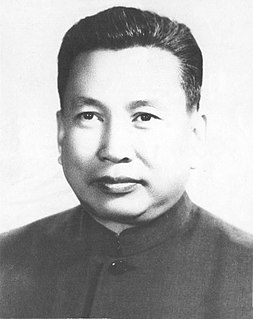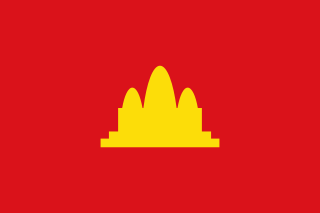Related Research Articles

Pol Pot was a Cambodian revolutionary and politician who governed Cambodia as Prime Minister of Democratic Kampuchea between 1976 and 1979. Ideologically a Marxist–Leninist and a Khmer nationalist, he was a leading member of Cambodia's communist movement, the Khmer Rouge, from 1963 until 1997 and served as the General Secretary of the Communist Party of Kampuchea from 1963 to 1981. Under his administration, Cambodia was converted into a one-party communist state and perpetrated the Cambodian genocide.

Marshal Lon Nol was a Cambodian politician and general who served as Prime Minister of Cambodia twice, as well as serving repeatedly as defence minister and provincial governor. As a nationalist and conservative, he led the military coup of 1970 against Prince Norodom Sihanouk, abolished the monarchy, and established the short-lived Khmer Republic. Constitutionally a semi-presidential republic, Cambodia was de facto governed under a military dictatorship. He was the commander-in-chief of the Khmer National Armed Forces during the Cambodian Civil War. After the Khmer Rouge captured Phnom Penh, Lon Nol fled to the United States, first to Hawaii and Michigan and then to California, where he remained until his death in 1985.

The Kingdom of Cambodia, also known as the First Kingdom of Cambodia, and commonly referred to as the Sangkum period, refers to Norodom Sihanouk's first administration of Cambodia from 1953 to 1970, an especially significant time in the country's history. Sihanouk continues to be one of the most controversial figures in Southeast Asia's turbulent and often tragic postwar history. From 1955 until 1970, Sihanouk's Sangkum was the sole legal party in Cambodia.

Son Sen, alias Comrade Khieu (សមមិត្តខៀវ) or "Brother Number 89", was a Cambodian Communist politician and soldier. A member of the Central Committee of the Communist Party of Kampuchea/Party of Democratic Kampuchea, the Khmer Rouge, from 1974 to 1992, Sen oversaw the Party's security apparatus, including the Santebal secret police and the notorious security prison S-21 at Tuol Sleng.

Ieng Sary was a Cambodian politician who was the co-founder and senior member of the Khmer Rouge. He was a member of the Central Committee of the Communist Party of Kampuchea led by Pol Pot and served in the 1975–79 government of Democratic Kampuchea as foreign minister and deputy prime minister. He was known as "Brother Number Three" as he was third in command after Pol Pot and Nuon Chea. His wife, Ieng Thirith, served in the Khmer Rouge government as social affairs minister. Ieng Sary was arrested in 2007 and was charged with crimes against humanity but died of heart failure before the case against him could be brought to a verdict.

The Khmer Issarak was a "loosely structured" anti-French and anti-colonial independence movement. Besides, the movement was labelled as “amorphous”. The Issarak was formed around 1945 and composed of several factions each with its own leader. Most of the Issarak bands fought actively between the end of the Second World War in 1945 and Cambodia’s independence in 1953. Initial objectives of the Khmer Issarak was to fight against the French in order to gain independence. Later, overthrowing the Cambodian government became some Issarak bands' agenda. Moreover, the term Issarak originally referred to non-communist, but in the early 1950s the Việt Minh guided-guerrillas called themselves Issaraks for the sake of unifying other non-communist forces.
Sơn Ngọc Thành was a Cambodian nationalist and republican politician, with a long history as a rebel and a government minister.
Lon Non was a Cambodian politician and soldier who rose to his greatest prominence during the Khmer Republic (1970–1975).

Hu Nim, alias "Phoas" (ភាស់), was a Cambodian Communist intellectual and politician who held a number of ministerial posts. His long political career included spells with the Sangkum regime of Prince Norodom Sihanouk, the Communist guerrilla resistance, the GRUNK coalition government-in-exile, and the administration of Democratic Kampuchea, when the country was controlled by the Communist Party of Kampuchea.

General elections were held in Cambodia on 9 June 1955. The elections were held following the peace established at the 1954 Geneva Conference and the independence of the country. The election were postponed to September 1955. The result was a landslide victory for the Sangkum party, which won all 91 seats. The election was marked by widespread voter fraud and intimidation. This began a period of one-party dominance of Prince Sihanouk's Sangkum until the coup of 1970.
Keo Meas was a Cambodian communist politician. Keo Meas, then a fourth-year student at the Phnom Penh Teachers Training College, was recruited to the Indochinese Communist Party by Son Sichan in 1946. In 1950, he became a leading figure within the United Issarak Front. At the same time he was a leading figure in the Phnom Penh city unit of the ICP.

PrinceNorodom Chantaraingsey was a member of the Cambodian royal family and a Cambodian nationalist. Initially a leader of the guerrilla resistance against the colonial French, he went on to become a prominent general in the Khmer National Armed Forces (FANK) during the Cambodian Civil War, as well as a businessman and occasional writer.
Tou Samouth, also known as Achar Sok (អាចារ្យសុក), was a Cambodian politician. One of the two founding members of the Kampuchean People's Revolutionary Party (KPRP), the other being Son Ngoc Minh, and head of its more moderate faction. He is mainly remembered for mentoring Saloth Sar, who would later change his name to Pol Pot.
Dap Chhuon, also known as Chuan Khemphet, Khem Phet, Chhuon Mochulpech or Chhuon Mchoul Pich (1912–1959) was a right-wing Cambodian nationalist, guerrilla leader, regional warlord, and general.

The Royal Government of the National Union of Kampuchea was a government-in-exile of Cambodia, based in Beijing, that was in existence between 1970 and 1976, and was briefly in control of the country starting in 1975.
The Krom Pracheachon, often referred to simply as Pracheachon, was a Cambodian political party that contested in parliamentary elections in 1955, 1958 and 1972.
The Democratic Party, commonly referred to as The Democrats, was a left-wing pro-independence political party formed in 1946 by Prince Sisowath Youtevong, who had previously been a member of the French Section of the Workers' International. It was the sole dominant party in Cambodia from 1946 until the creation of Sangkum in 1955.
Prince Norodom Phurissara was a prominent leftist Cambodian politician of the 1950s, 1960s and 1970s, who held a number of ministerial posts. A member of the Cambodian royal family, he disappeared during the political purges carried out by the Communist Party of Cambodia after it came to power.

Keng Vannsak was a Cambodian scholar, philosopher and Khmer linguist. He invented the Khmer typewriter keyboard in 1952. He lived in exile in Paris, France, from 1970 until his death in 2008. He died at the age of eighty-three at the hospital of Montmorency in the outskirts of Paris after suffering from a chronic illness.

The Communist Party of Kampuchea (CPK), also known as the Khmer Communist Party, was a communist party in Cambodia. Its leader was Pol Pot and its followers were generally known as the Khmer Rouge. Originally founded in 1951, the party was split into pro-Chinese and pro-Soviet factions as a result of the Sino–Soviet split with the former being the Pol Pot faction, and the latter adopting a more revisionist approach to Marxism. As such, it claimed 30 September 1960 as its founding date, then as the Workers' Party of Kampuchea before being renamed the Communist Party in 1966.